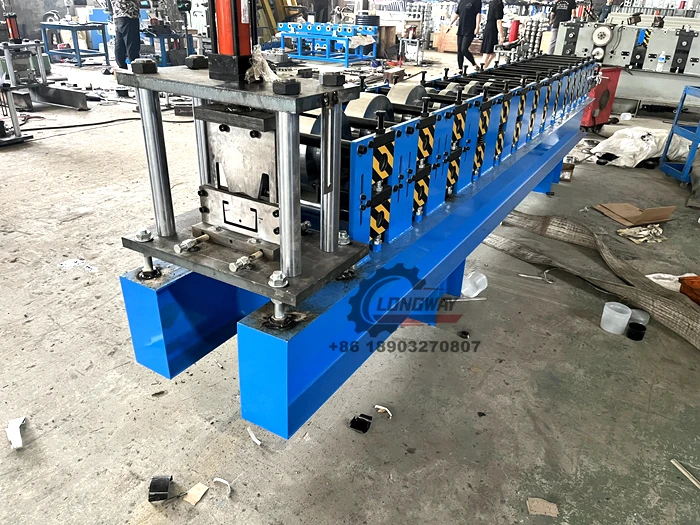Efficient Purlin Production Solutions for Modern Construction Needs
The Versatile World of Purlin Machines An Overview
In the realm of construction and manufacturing, efficiency and precision are paramount. One of the tools that exemplifies these qualities is the purlin machine. This machine plays a vital role in the production of purlins—horizontal structural members that support the weight of a roof and distribute loads to vertical beams. Understanding the functionality, types, benefits, and applications of purlin machines is essential for industry professionals looking to enhance their operations.
What Are Purlins?
Purlins are critical components in building frameworks, primarily made of steel or other metals. They provide support for roofing sheets, ensuring that they remain securely fastened over the building's span. Purlins can be either C-shaped or Z-shaped, with each type serving different structural needs. C-purlins are typically used for smaller buildings, while Z-purlins are employed for larger structures requiring enhanced load-bearing capacity.
The Role of Purlin Machines
Purlin machines automate the process of manufacturing purlins, significantly increasing productivity and reducing labor costs. These machines are designed to take raw metal materials, typically in coil form, and transform them into precisely shaped purlins. The process involves several steps, including roll forming, cutting, and punching, all of which can be executed seamlessly in a single operation.
Types of Purlin Machines
There are several types of purlin machines available on the market, each designed for specific production needs
1. C Purlin Machines These machines produce C-shaped purlins using roll forming technology. They can handle different sizes and thicknesses, providing versatility in applications.
2. Z Purlin Machines Similar to C purlin machines, Z purlin machines produce Z-shaped purlins. They are particularly useful for constructing larger buildings and are preferred for their enhanced strength and stability.
3. Combined Purlin Machines These machines are capable of producing both C and Z purlins. They offer flexibility for manufacturers who wish to switch between types without investing in multiple machines.
Benefits of Using Purlin Machines
purlin machine

The adoption of purlin machines comes with numerous advantages
- Increased Efficiency By automating the manufacturing process, purlin machines enable high production rates and minimize downtime, allowing businesses to meet tight project deadlines.
- Cost-Effectiveness Reducing manual labor and streamlining the forming process lowers operational costs significantly. This can lead to higher profit margins for manufacturers.
- Precision Engineering Modern purlin machines are equipped with advanced technology that ensures precise dimensions and consistent quality in every batch of purlins produced.
- Material Optimization These machines maximize the use of raw materials, reducing waste and contributing to more sustainable manufacturing practices.
Applications of Purlin Machines
Purlins produced by these machines cater to a wide variety of industries. Common applications include
- Agricultural Buildings Purlins are essential in constructing barns, greenhouses, and storage facilities, offering robust support for roofing.
- Industrial Facilities Factories and warehouses utilize purlins for their structures, benefiting from their strength and versatility.
- Commercial Buildings Retail spaces, shopping malls, and office buildings often incorporate purlins in their design, ensuring durability and structural integrity.
- Residential Housing Increasingly, purlins are being used in residential construction, particularly in modern designs where open spaces are desired.
Conclusion
In conclusion, purlin machines represent an essential innovation in the construction and manufacturing industries. Their ability to efficiently produce high-quality purlins has made them indispensable for builders and manufacturers alike. As the demand for efficient building solutions grows, so too does the importance of purlin machines in meeting these challenges. With advancements in technology, these machines are likely to become even more refined, further enhancing their role in the future of construction. Whether for agriculture, industry, or commercial purposes, the impact of purlin machines is undeniable, marking a significant stride towards smarter manufacturing processes.
-
Roof Panel Machines: Buying Guide, Types, and PricingNewsJul.04, 2025
-
Purlin Machines: Types, Features, and Pricing GuideNewsJul.04, 2025
-
Metal Embossing Machines: Types, Applications, and Buying GuideNewsJul.04, 2025
-
Gutter Machines: Features, Types, and Cost BreakdownNewsJul.04, 2025
-
Cut to Length Line: Overview, Equipment, and Buying GuideNewsJul.04, 2025
-
Auto Stacker: Features, Applications, and Cost BreakdownNewsJul.04, 2025
-
Top Drywall Profile Machine Models for SaleNewsJun.05, 2025








